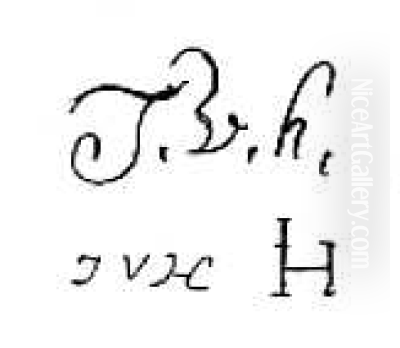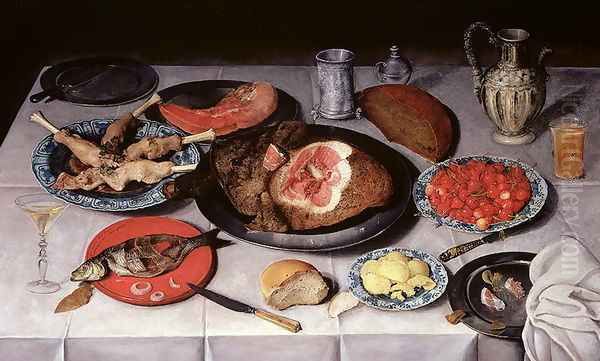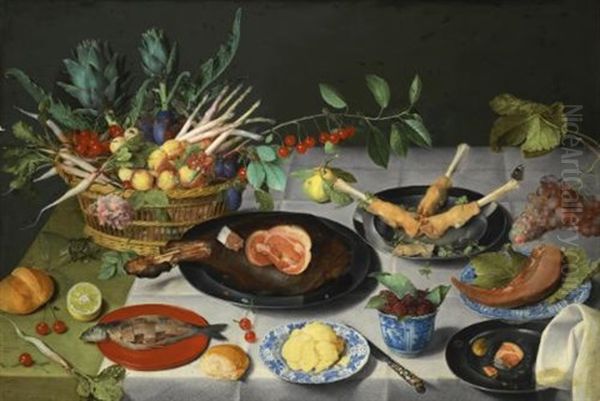
Jacob van Hulsdonck stands as a significant figure in the early development of Flemish still life painting during the vibrant artistic period of the late 16th and early 17th centuries. Born in Antwerp in 1582 and passing away in the same city in 1647, his life spanned a crucial era of artistic innovation in the Southern Netherlands. Hulsdonck carved a distinct niche for himself, specializing in meticulously rendered still lifes, particularly compositions featuring fruit and flowers, which showcased his exceptional technical skill and keen observational powers. He is recognized as one of the foundational masters who helped establish still life as an independent and respected genre in Flanders.
Formative Years in Antwerp and Middelburg
Jacob van Hulsdonck's artistic journey began in Antwerp, a bustling metropolis and a major European center for arts and commerce. However, his formative years were spent away from his birthplace. His family relocated to Middelburg, the capital of Zeeland, likely due to the religious and political turmoil of the Eighty Years' War, which saw many Protestant families move north. Middelburg itself was developing into a notable artistic center, particularly for still life and landscape painting.
It was in Middelburg that Hulsdonck likely received his initial artistic training. While definitive proof is lacking, art historians speculate that he may have come under the influence of Ambrosius Bosschaert the Elder (1573-1621), a leading pioneer of flower painting who was active in Middelburg during Hulsdonck's youth there. Bosschaert's highly detailed and often symmetrically arranged floral pieces certainly set a precedent for the meticulous style that would later characterize Hulsdonck's own work, even if a direct apprenticeship cannot be confirmed. The environment in Middelburg, with its concentration of artists interested in the close observation of nature, undoubtedly played a role in shaping his artistic inclinations.
Return to Antwerp and Guild Membership

By 1608, Jacob van Hulsdonck had returned to his native Antwerp. This move marked a significant step in his professional career. In that same year, he was officially registered as a master painter in the prestigious Guild of Saint Luke of Antwerp. Membership in the Guild was essential for any artist wishing to practice independently, take on pupils, or sell their work within the city. It signified that Hulsdonck had achieved a recognized level of competence and was ready to establish his own workshop.
Antwerp, at this time, was experiencing a resurgence under the Archdukes Albert and Isabella, often referred to as the Flemish Baroque period. While Peter Paul Rubens (1577-1640) dominated the scene with his grand historical and religious canvases, there was also a thriving market for other genres, including still life. Hulsdonck entered a competitive but fertile artistic environment, ready to make his mark with his specialized skills. His return placed him back in the heart of Flemish artistic production.
Artistic Style: Precision and Luminosity
Jacob van Hulsdonck's reputation rests firmly on his mastery of the still life genre. He primarily focused on compositions featuring arrangements of fruit, often presented in bowls or baskets, and occasionally flower pieces. His style is characterized by an extraordinary attention to detail and a remarkable degree of realism. He rendered textures with painstaking care – the velvety skin of a peach, the waxy sheen of plums, the segmented translucency of a peeled lemon, the delicate veins of a flower petal, or the cool reflectivity of a Wan-Li porcelain bowl.
His compositions are typically straightforward and balanced, often featuring a central motif placed on a simple wooden tabletop, viewed slightly from above. The background is usually dark and neutral, serving to throw the brightly lit objects into sharp relief. Hulsdonck employed a clear, even light that illuminates the subjects precisely, modeling their forms and highlighting their textures without dramatic chiaroscuro. This careful handling of light and shadow contributes to the sense of clarity and stillness that pervades his work. His color palette is rich yet controlled, capturing the natural hues of fruits and flowers with remarkable fidelity. This combination of precise drawing, detailed rendering, and luminous clarity defines his distinctive artistic signature.
Influences and Connections: Shaping a Vision

While the potential early influence of Ambrosius Bosschaert the Elder in Middelburg is noted, Hulsdonck's style upon his return to Antwerp shows a closer affinity with the work of Osias Beert the Elder (c. 1580-1623/24). Beert was another leading figure in the first generation of Antwerp still life specialists, known for his 'breakfast pieces' (ontbijtjes) and fruit arrangements laid out on tabletops. The similarities in composition, subject matter, and meticulous technique suggest that Hulsdonck may have worked in Beert's circle or perhaps even directly studied with him after returning to Antwerp. Both artists shared an additive approach to composition, carefully placing individual items across the picture plane.
Hulsdonck worked contemporaneously with other major Antwerp artists who also depicted elements of still life, albeit often within larger compositions or with a different emphasis. Frans Snyders (1579-1657), for instance, was renowned for his large, dynamic market scenes and hunting pieces overflowing with fruit, game, and vegetables, displaying a more robust and painterly style. Jan Brueghel the Elder (1568-1625), famous for his 'Velvet' touch, incorporated exquisite floral arrangements and detailed objects into his allegorical and landscape paintings. While Hulsdonck's focused, intimate still lifes differ in scale and intent from the works of Snyders or Brueghel, they all contributed to the rich tapestry of Flemish Baroque art. Some scholars have also noted a subtle affinity with the heightened realism and focused light found in the works of the Italian master Caravaggio (1571-1610), whose influence permeated European art, although any connection for Hulsdonck would likely be indirect.
Masterworks: A Closer Look
Despite a career spanning nearly four decades, Jacob van Hulsdonck's known oeuvre is relatively small, comprising around 100 paintings. However, these works consistently demonstrate his high level of skill and refined aesthetic. Several paintings stand out as representative examples of his artistry.
Still Life with Lemons, Oranges, and a Pomegranate (various versions exist, e.g., Getty Center, Los Angeles, c. 1620-40; Prado Museum, Madrid): This composition is one of his most celebrated. It typically features citrus fruits, some peeled or sliced to reveal their inner structure and texture, alongside a pomegranate, often bursting open to show its jewel-like seeds. These works exemplify Hulsdonck's mastery in rendering different surfaces and his ability to capture the play of light on fruit peel and pulp.
Breakfast Piece (e.g., Rijksmuseum Twenthe, Enschede, c. 1615): Following the tradition established by artists like Osias Beert and Clara Peeters (c. 1587-after 1636), Hulsdonck created 'breakfast pieces' or 'banquet pieces'. These works depict arrangements of food items like bread, cheese, fruit, nuts, and wine, often accompanied by fine tableware like glasses and pewter plates. The Breakfast Piece in Twenthe is noted for its relatively complex layout and detailed rendering of various foodstuffs and objects.
Wild Strawberries and a Carnation in a Wan-Li Bowl (National Gallery of Art, Washington D.C.): This painting highlights Hulsdonck's skill in depicting delicate subjects like wild strawberries. Significantly, it also features a Chinese blue-and-white porcelain bowl from the Wan-Li period (1573-1620). The inclusion of such imported luxury items was common in Dutch and Flemish still lifes, reflecting the global trade networks of the time and adding an element of exoticism and value to the composition.
Plums and Peaches on a Silver Platter (Grasset Collection): This work showcases Hulsdonck's ability to render the soft, downy texture of peaches and the smooth, waxy skin of plums with convincing realism. The reflective silver platter adds another element of technical challenge, which he handles with subtlety. The provenance of this piece, having been in private Swiss collections before being sold at Christie's in 1988, speaks to the long-standing appreciation of his work among collectors.
Roses in a Glass Vase (Mauritshuis, The Hague): While fruit compositions dominate his output, Hulsdonck also painted pure flower pieces. This example demonstrates his ability to capture the delicate structure and velvety texture of rose petals, arranged simply in a transparent glass vase, showcasing his skill with both botanical accuracy and the rendering of glass.
Other works, like the Still Life with Meat, Fish, Vegetables, and Flowers (Cleveland Museum of Art, c. 1615-1620), show a broader range of subjects, perhaps leaning towards the market-style scenes associated more with Snyders or Beert, but still rendered with Hulsdonck's characteristic precision.
The Signature Style: Consistency and Rarity
One of the remarkable aspects of Jacob van Hulsdonck's career is the consistency of his style. From his early works around 1608 until his death in 1647, his paintings maintain a high level of finish, a similar compositional structure (often a basket or bowl centered on a ledge), and a characteristic handling of light and detail. He typically signed his works with the full name or initials, often as "IVHULSDONCK.FE(CIT)" (Jacob van Hulsdonck made it), usually on the wooden tabletop ledge.
However, a significant challenge for art historians is that Hulsdonck rarely dated his paintings. This makes establishing a precise chronology of his work difficult. While some general stylistic evolution might be discerned, the overall consistency means that dating relies heavily on comparative analysis and technical examination (like dendrochronology of the wood panels he typically painted on). The relative scarcity of his works, combined with their consistent quality, has made them highly sought after by museums and collectors. His focused approach contrasts with the more elaborate and opulent still lifes that became fashionable later in the 17th century, as seen in the work of artists like Jan Davidsz. de Heem (1606-1684).
Family Ties and Artistic Succession
The practice of art often ran in families during the 17th century, and the Hulsdoncks were no exception. Jacob trained his own son, Gillis van Hulsdonck (c. 1625 – after 1669), who also became a still life painter. Gillis was registered as a master in the Antwerp Guild of Saint Luke in the guild year 1645/46. While Gillis followed in his father's footsteps, specializing in fruit still lifes, his works are generally considered less refined than Jacob's, and fewer examples survive. The existence of a family workshop underscores the way artistic skills and styles were often passed down directly from one generation to the next. There is also speculation, as mentioned earlier, that Jacob himself might have initially trained with an uncle who was also a painter, further embedding his artistic path within familial connections, although this remains unconfirmed.
Enduring Influence and Legacy
Jacob van Hulsdonck played a crucial role in the early development of Flemish still life painting. Alongside contemporaries like Osias Beert the Elder and Ambrosius Bosschaert the Elder (and his dynasty, including Balthasar van der Ast), Hulsdonck helped elevate still life from a minor element within larger paintings to an independent genre appreciated for its technical virtuosity and aesthetic appeal. His meticulous technique, clear compositions, and luminous rendering of textures set a high standard.
His influence extended beyond his immediate circle and lifetime. Later generations of Flemish still life painters, such as Jan Pauwel Gillemans the Elder (1618-1675) in Antwerp, built upon the foundations laid by Hulsdonck and his contemporaries. Furthermore, the clarity and precision of Flemish and Dutch still lifes, including those by Hulsdonck, resonated elsewhere in Europe. For instance, the French still life painter Louise Moillon (1610-1696), known for her similarly precise and clearly arranged fruit compositions, is believed to have been influenced by the Netherlandish models that were available in Paris. His work can also be seen in dialogue with meticulous still life traditions developing elsewhere, such as the work of the German painter Georg Flegel (1566-1638) or the Spanish master Juan van der Hamen y León (1596-1631), highlighting a broader European interest in the detailed depiction of the natural world during this period.
Hulsdonck in Collections Worldwide
The enduring appeal and art historical importance of Jacob van Hulsdonck's work are reflected in its presence in major museum collections across the globe. His paintings are held by prestigious institutions, including:
The J. Paul Getty Museum, Los Angeles
The Prado Museum, Madrid
The Cleveland Museum of Art
The Metropolitan Museum of Art, New York
The National Gallery of Art, Washington D.C.
The Mauritshuis, The Hague
The Rijksmuseum Twenthe, Enschede
The Bowes Museum, Barnard Castle, UK
Musée des Beaux-Arts d'Orléans, France
Musée Calvet, Avignon, France (these latter two holding the only known works by Hulsdonck in French public collections)
Private collections like the Grasset Collection also hold significant examples.
His works are regularly featured in exhibitions focusing on Flemish painting or the development of still life. For example, the Plums and Peaches on a Silver Platter from the Grasset Collection was exhibited at The European Fine Art Fair (TEFAF) in Maastricht in 2016 and 2019, bringing his work to the attention of contemporary audiences and collectors. The inclusion of his paintings in these internationally renowned venues underscores his status as a key figure in European art history.
Conclusion: An Enduring Vision of Stillness
Jacob van Hulsdonck remains a pivotal figure in the history of Flemish art. As one of the pioneers of independent still life painting in Antwerp, he brought a unique combination of meticulous observation, technical refinement, and compositional clarity to the genre. His depictions of fruit and flowers, rendered with almost scientific precision yet imbued with a quiet beauty, capture the essence of the early Baroque fascination with the natural world. Though his output was not vast, the consistent quality and distinctive style of his work secured his reputation during his lifetime and continue to earn him admiration today. His legacy lies not only in his beautiful paintings but also in his contribution to establishing still life as a significant and enduring genre within the rich tradition of European art. His work offers a window onto the world of 17th-century Flanders, celebrating the simple beauty of everyday objects with extraordinary skill and dedication.